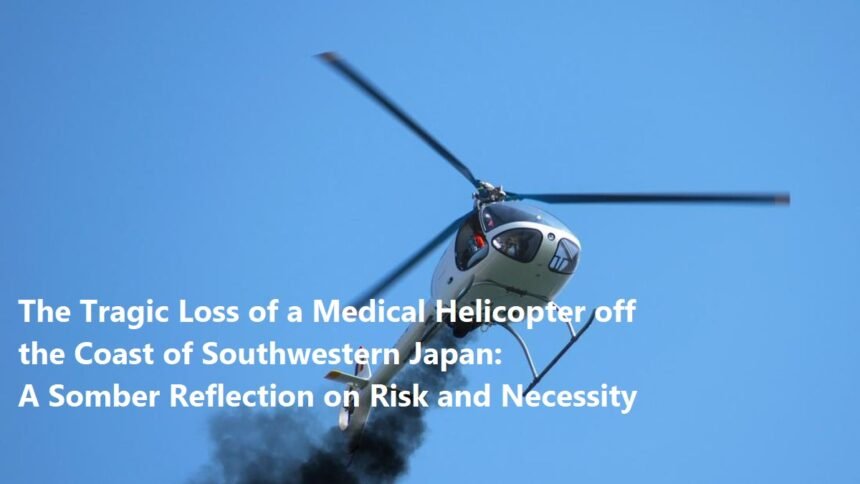The news on Sunday, April 6th, 2025, reverberated with grim finality: a medical helicopter had crashed into the sea off the southwestern coast of Japan, claiming the lives of three individuals, including a patient receiving critical care. The incident, involving a helicopter carrying six passengers en route to a hospital in Fukuoka, Nagasaki Prefecture, has cast a long shadow, prompting profound grief and raising essential questions about the inherent risks associated with emergency medical transportation. The utterance of hospital director Ryuji Tominaga, describing the tragedy as “heartbreaking,” encapsulates the collective sense of loss felt by the community, the medical professionals, and the nation at large.
The use of medical helicopters, often referred to as air ambulances, has become an indispensable component of modern healthcare systems. Their rapid deployment and ability to traverse significant distances in a relatively short timeframe are crucial in reaching patients in remote areas, transferring individuals requiring specialized care to advanced facilities, and responding to trauma incidents where time is of the essence. This capability is particularly vital in a nation like Japan, characterized by both densely populated urban centers and geographically isolated rural communities, where ground transportation can be significantly hampered by terrain, distance, or traffic congestion. In such contexts, the airborne delivery of medical assistance is not merely a convenience; it is often a lifeline.
However, the very advantages that make medical helicopters so valuable also expose them to inherent risks. The demanding nature of their missions, which often involve operating in challenging weather conditions, over water, and at low altitudes, necessitates highly skilled pilots and stringent maintenance protocols. Furthermore, the presence of critically ill or injured patients onboard adds another layer of complexity, requiring trained medical personnel capable of administering life-saving interventions while navigating the turbulent environment within the aircraft. The delicate balance between the urgency of the situation and the paramount need for safety is a constant concern in the realm of emergency medical aviation.
The circumstances surrounding the crash on April 6th remain under investigation. Understanding the precise sequence of events that led to the helicopter’s descent into the sea will be crucial in determining the underlying causes of the accident. Weather conditions at the time of the flight, potential mechanical failures, and human factors will all be subject to rigorous scrutiny. While speculation is premature, the investigation will undoubtedly focus on identifying any vulnerabilities in the existing safety protocols and implementing corrective measures to prevent similar tragedies from occurring in the future.
The ramifications of this incident extend beyond the immediate grief and the investigative process. It necessitates a thorough review of the safety standards governing medical helicopter operations in Japan. This review should encompass a comprehensive assessment of pilot training requirements, aircraft maintenance procedures, and operational guidelines, with a particular emphasis on mitigating the risks associated with flying over water. Furthermore, the incident underscores the importance of ongoing investment in advanced aviation technology, including sophisticated navigation systems, enhanced weather monitoring capabilities, and improved aircraft design, all of which can contribute to a safer operating environment.
Beyond the technical considerations, the tragedy also prompts a deeper reflection on the ethical considerations inherent in emergency medical transportation. Balancing the potential benefits of rapid medical intervention with the inherent risks of air travel requires careful deliberation and informed decision-making. Medical professionals, pilots, and administrators must collaborate to assess the potential risks and benefits of each flight, taking into account the patient’s condition, the weather conditions, and the availability of alternative modes of transportation. Transparency and open communication with patients and their families regarding the potential risks are also paramount.
In the wake of this devastating event, the focus must be on honoring the memory of those who lost their lives by learning from this tragedy and implementing comprehensive measures to enhance the safety of medical helicopter operations. This includes not only addressing the technical and operational aspects of aviation safety but also fostering a culture of vigilance, risk awareness, and continuous improvement within the emergency medical aviation community. The pursuit of these goals is not merely a matter of regulatory compliance; it is a moral imperative, driven by the desire to ensure that the delivery of critical medical care remains as safe and effective as possible. Only through such diligent efforts can we hope to prevent future heartbreak and protect the lives of those who rely on the vital service provided by medical helicopters. The loss on April 6th should serve as a somber reminder of the delicate balance between risk and necessity, a balance that demands unwavering attention and a commitment to continuous improvement in the pursuit of safety.












